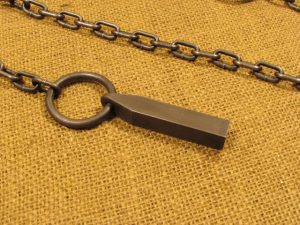 The manrikigusari, or 10,000 powers chain, also called the ryofundogusari, or double weighted chain, is yet another obscure Japanese weapon. The story about its origins that I like best is that the samurai who guarded Edo castle were forbidden from spilling blood, and so they set aside their usual weapons in favor of this unusual but effective weapon. The same story tells us that this is a modification of the kusarigama, or sickle and chain, with the sickle removed to create a weapon with no blade. I’m not certain I buy that because the kusarigama is Okinawan, and the samurai were not fans of the Okinawans.
The manrikigusari, or 10,000 powers chain, also called the ryofundogusari, or double weighted chain, is yet another obscure Japanese weapon. The story about its origins that I like best is that the samurai who guarded Edo castle were forbidden from spilling blood, and so they set aside their usual weapons in favor of this unusual but effective weapon. The same story tells us that this is a modification of the kusarigama, or sickle and chain, with the sickle removed to create a weapon with no blade. I’m not certain I buy that because the kusarigama is Okinawan, and the samurai were not fans of the Okinawans.
Concealable and Versatile
This is perhaps the most effective flexible weapon I’m aware of, being not so long as to make it impossible to control, but long enough to create considerable reach. There are no rules, but a typical gusari is between 18 and 36 inches, with 20–24 inches being fairly typical. It’s quite versatile and can be used for strikes, chokes, traps, and throws. It’s also very small and concealable. One favored technique is to hold the coiled chain in one hand and throw one weight while holding on to the other.
Although not impossible to control, this weapon is very difficult to learn and use effectively.
Don’t Beat Yourself Up
Flexible weapons have the nasty tendency of biting the operator, and this one is no exception. It’s hard to control when swung, and the weights will cause a very deep bruise every time. If it strikes an area over bone, it will cut, despite its being considered a “bloodless” weapon. In expert hands, however, it can be concealed and then quickly deployed to devastating effect.
This one is very simple to make, and the materials are inexpensive mild (low carbon) steel. I’ve used materials of various sizes, but I think I’ve settled on 1/2” square bar, 3” long, drilled and ground thinner on one end to receive the ring. The ring is either 3/16” round bar, or a link from larger chain. I cut the ring and bend it open, put on the chain and weight, bend the ring closed, and MIG weld the seam.
A short soak in ferric chloride followed by a cold blue in 50/50 selenium / phosphoric acid, and it’s done. I think the cold blue really gives it the appearance of age.
Manriki-gusari . . . Do you-gusari?



When I was still studying Bujinkan Ninjutsu the kusari was always one of my favorite weapons, very versatile and concealable.
Pre 9/11 I remember our sensei sneaking one through security by leading the “security guard” around his bag, always pushing the kusari just out of view and making sure she never found anything, not that he would actually do something with it, he just didn’t want to go through the hastle of having to check it when he only had the one cary-on bag.
@ShadowAcid – Leave it to a ninja to be sneaky.
:)
I always loved this simple but most efficient tool.
Thank you, Todd, for your enlightening post.
@The Bull – you are most welcome!
Cool manrikigusari and it looks painful to learn, but I’ve got a bladesmithing question that has been nagging me since I had the misfortune to see the last ‘Conan the Barbarian’ movie: in the movie the cimmerians create blades by pouring iron/steel into a mold. Is that even feasible (yes I guess) and will that create a good enough blade?
I am sorry to drag attention away from the manrikigusari, but you are the only bladesmith I know and the question must be answered (maybe in a separate Real Steel?).
@Darkjoy – I don’t know a whole lot about casting steel, but here’s a little:
There’s a maker named David Boye who makes cast “dendritic steel” knives, but they aren’t really steel, they’re a cobalt / chromium alloy.
There are cast steel anvils, but I know nothing about anvil making.
It’s really not practical, because heating the steel to molten changes the composition too much, including burning off carbon. It would really have to be done during the smelt to be practicle, because the conditions and ingredients are tightly controlled. Melt it again and you change everything.
To answer the question with a question: Being that’s it’s practicle to change the shape of steel bt forging and grinding, why melt and cast it (which isn’t practicle)?
Todd,
To answer your question: because liquid metal looks cool and in a movie cool equals $.
Good to know that my gut reaction of “what the …. that is not how you forge a blade” was right, must be your influence.
I will look up those denditic steel blades. Thanks for the information.
I feel like the manrikigusari had its roots as some other mundane tool… like tying down curtains or something :P
Either way, awesome post. These improvised weapons are awesome because anyone can “make” them!
@Gary – Thanks, Gary!